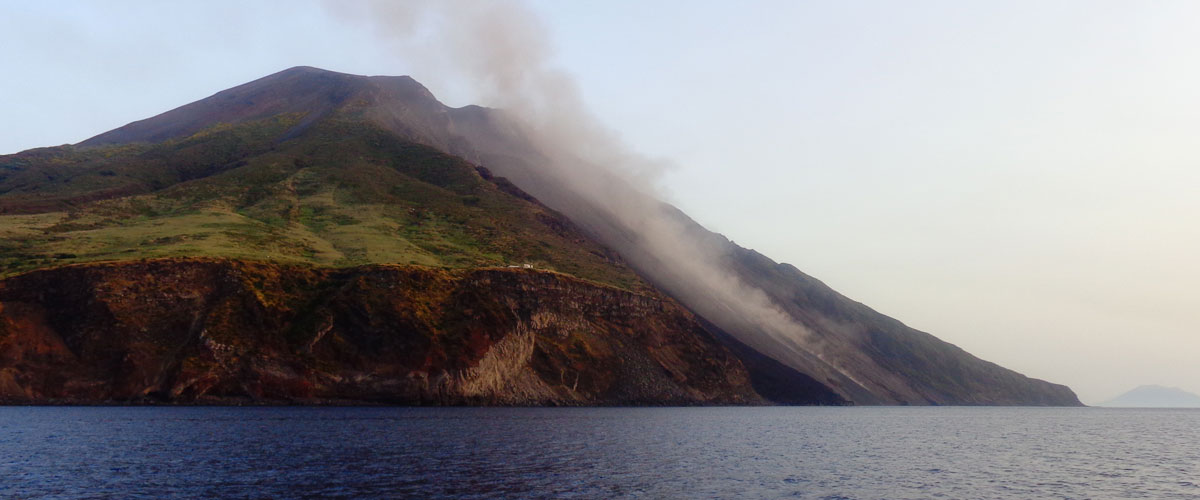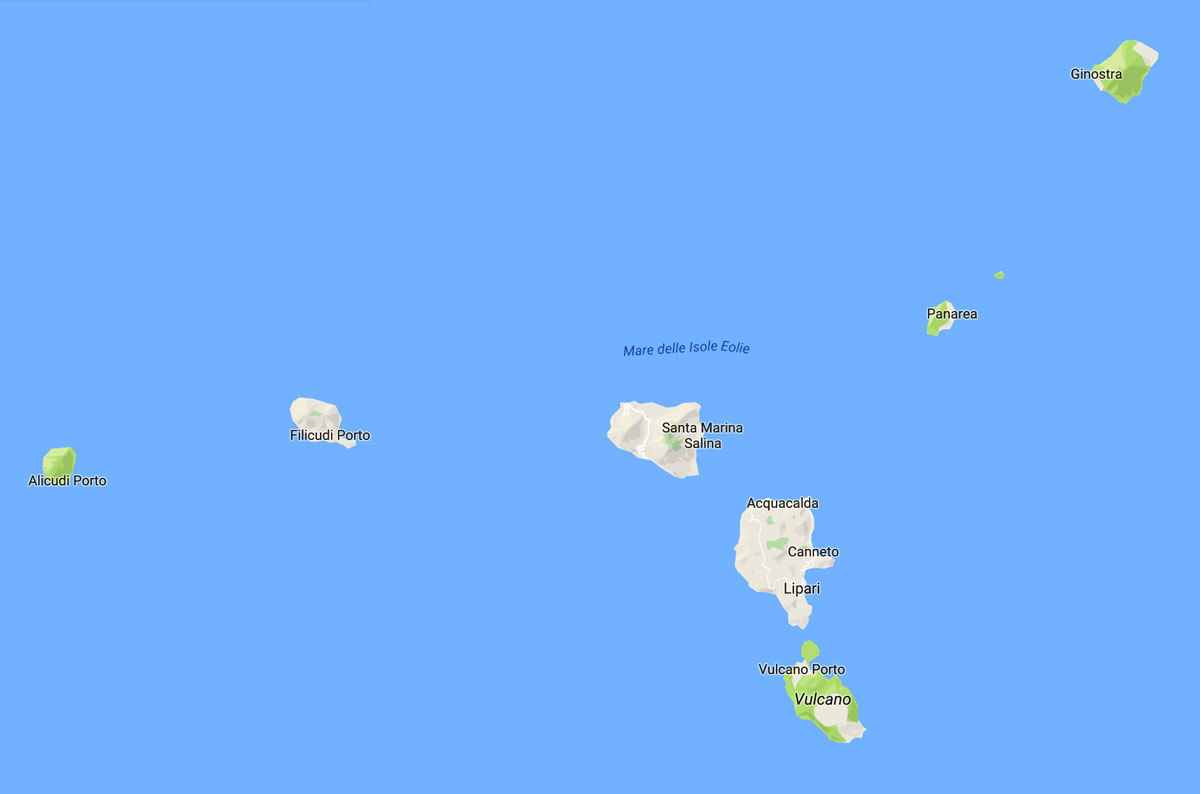
The Aeolian Islands
Born from volcanic eruptions and carved by the force of the wind and sea , the archipelago of the Aeolian Islands is located in the eastern sector of the Southern Tyrrhenian Sea, off the north coast of Sicily. It consists of seven islands: Lipari, Salina, Vulcano, Stromboli , Panarea , Filicudi and Alicudi. Its name has mythological roots , because in ancient times it was believed that Aeolus, god of the winds, had his home here. In addition, the presence of active volcanoes – a phenomenon which is still visible – led to believe that Hephaestus / Vulcan, powerful god of fire also lived here. The human presence on these islands has a long history. As early as the fourth millennium BC the Aeolian Islands ( Lipari in particular) were popular for the exploitation of obsidian, black solidified lava, extremely hard and sharp, used to make weapons and tools. The extraction, processing and trade of this product made the Aeolian archipelago an important commercial hub. In addition, its location in the northwest of the Strait of Sicily was a strategic position that allowed the civilisations of the ancient Mediterranean to expand their commercial and cultural influence. With the discovery of metals the trade in obsidian gradually declined and over the centuries the Aeolian history was characterised by alternating phases of economic prosperity and decline. In the Bronze Age there was intense trade with the Aegean, Sicily and Apennine areas, cultural encounters that left wonderful archeological sites such as the village of Capo Graziano on Filicudi , the village of Panarea in the picturesque setting of Cala Junco, the settlement Portella on Salina and the incredible archaeological stratification visible in the ancient acropolis of Lipari. The Aeolian history over the centuries is full of events and changes: the islands were colonised by the Greeks and were of interest to the Etruscans and the Phoenicians. They then built an alliance with the Carthaginians and became Roman in 252 BC . Numerous archaeological remains are testimony of this long history and a visit to the Archaeological Museum of Lipari is not to be missed. In the Middle Ages , the islands were threatened by the Saracen attacks, abandoned and then inhabited by the Normans until the siege and destruction of
Lipari
Lipari in 1544 by the pirate Barbarossa, who enslaved its 8,000 inhabitants. With the Spanish domination Lipari was rebuilt and the entire archipelago flourished through economic activities mainly related to agriculture, viticulture and fishing . After the massive migration to America and Australia that characterised the nineteenth and twentieth centuries, today the Aeolian Islands have become a very popular tourist resort. The current population is approximately 12,000 inhabitants, divided into four municipalities , three of which are on Salina (Leni, Malfa and Santa Marina) and the remainder, Lipari, which includes the islands of Lipari, Vulcano, Panarea, Stromboli, Filicudi and Alicudi.
The typical white architecture well integrated with the landscape, the scented and colorful flora, the food and wine, the birds, the archaeology and geology provide countless reasons to visit. The Aeolian Islands are similar but have different characters and characteristics. All deserve to be visited, lived and loved. We have dedicated a page to our island
Salina
Salina within this site. Lipari is the largest island, with an area of 37,6 square kilometers and about 9,000 inhabitants. Its town is the richest of tourist and entertainment facilities, it houses the Archaeological Museum and has various harbours. The western side is full of caves and cliffs, while to the east the coast is gentler and provides easy access to several beaches: Canneto, Porticello and Spiagge Bianche (trans. White Beaches). These are named after the white pumice stone, which makes the seabed white and the sea of an intense blue. The interior is cultivated mostly with vines and offers beautiful view points. The Terme di San Calogero deserve a visit as they are the oldest thermal spas in the world, dating back to the seventeenth century BC.
Vulcano
Vulcano is the most southerly island of the archipelago, the closest to the Tyrrhenian coast of Sicily. It has an area of 21 square kilometers and about 400 inhabitants. Among its volcanic cones stands the Great Crater, characterised by its ‘fumarole’ and ‘lunar’ landscapes. Its last eruption dates back to 1888 and the volcano is permanently monitored by experienced volcanologists. A stone’s throw from the harbour are the most popular beaches: the beach of Porto Ponente, a bay with beautiful black sand and the beach of Porto Levante, where underwater geysers make the water hot and bubbly. In the same area there are hot mud baths while the rest of the island can be discovered by land or sea. To the north is Vulcanello, a volcanic islet connected to Vulcano by an isthmus and famous for its extravagant lava formations; to the west is the Cave of the Horse and the Pool of Venus, providing unforgettable opportunities for swimming and diving; to the south are the old lighthouse and the beach Gelso (trans. Mulberry); in the interior is the village of Lentia, surrounded by beautiful vegetation.
Filicudi
Filicudi, conical in shape but with a strip of flat land that juts out to the promontory of Capo Graziano, is an island of great charm, dominated by the unspoilt Mediterranean vegetation, fragrant and wild. Viewed from the sea the island is rocky and harsh but it offers some of the most beautiful natural attractions of the Aeolian archipelago: the Grotta del Bue Marino, where once lived seals; the imposing cliff called ” the rod “; and the arc of Punta Pertica. There are three towns inhabited by a total of about 300 people: Filicudi Porto, Val di Chiesa and the small and beautiful village of Pecorini a Mare.
Alicudi
Alicudi is the westernmost island and its surface is about 5 square kilometers. Far away from Lipari and the world, Alicudi has less than 100 inhabitants, it has no roads but stairways, no cars but mules carrying things and people to the highest part of the village. For those used to noisy city life, its silence is refreshing. The beauty of its landscape, its clear waters, slow rhythms and ancient ways of life make it a must-see destination for anyone who wants to find peace and tranquility.
Panarea
Panarea, geologically, is the oldest of the Aeolian Islands and although today the smallest (3.3 square kilometers), it was originally much larger. Some of the original lava material now forms small islands: Basiluzzo, Dattilo, Spinazzola, Bottaro, Lisca Nera, Lisca Bianca, Formiche and Panarelli. These islets make a beautiful backdrop for bathing and diving, sometimes made more interesting by submarine volcanic activity. San Pietro is a small village and the beautiful bays of Cala degli Zimmari and Cala Junco are enchanting.
Stromboli
Stromboli is the ‘volcano island’. Its conical shape and constant volcanic activity make it a truly unique destination where to come very close to the creative force of nature. With its 12,6 square kilometers, it is geologically the youngest island of the archipelago, and even today there are frequent eruptions. By land, for those accompanied by a guide, and by sea, for those who prefer to travel by boat, it is possible to witness the spectacle of explosions, smoke and incandescent rocks at the Sciara del Fuoco. Among various small villages is Ginostra, a quiet and isolated place on the northeastern side of the island, which has maintained the pace and feel of the past.




Comments are closed.